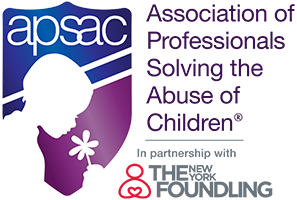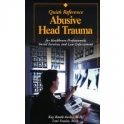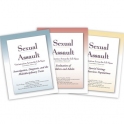
A Note About Shipping: Items that ship directly from the APSAC office will automatically calculate shipping in your cart using USPS Media Mail Prices. Items that ship from other locations will have shipping cost included in the item price. Downloadable documents will not incur shipping costs.
A Note to Members: Please be sure you are logged in so that you receive special member pricing. If you are not sure if you're logged in, please do so here.
If you have any questions about the store, or wish to inquire about a bulk order, please email info@apsac.org.
Looking for APSAC merchandise? Click here!
- Introduction to the Special Issue: Evidence Supports APSAC’s Position Calling to End Corporal Punishment in all U.S. Homes and Schools
- APSAC Members’ Responses to a Survey of Attitudes and Beliefs
- APSAC’s Position Statement on Corporal Punishment of Children
- Corporal Punishment in Schools
- Corporal Punishment: Evaluation of an Intervention by PNPs
- Welcoming Children to the Family of Humanity
- Dane County District Attorney’s Office Efforts to Reduce Corporal Punishment Through Criminal Justice Reform and Community Engagement |
- Shaping Child Welfare Practices in America and Beyond
- Literature Review, Washington Update, News of the Organization, and Conference Calendar
- Current Challenges in Addressing the Realities of Poverty and Inequality in Families with Young Children: A Call for Both Policy and Intervention
- The Forgotten Victims: Children of Incarcerated Parents
- Understanding Juvenile Probation Officers
- At Issue: Rethink the Label Insular Communities When Referring to Child Abuse
- An Education Agenda for Those Who Need It Most
- Threats to the Medically Complex Child
- Introduction to the Special Issue: Munchausen by Proxy: Abusive by Pediatric Condition Falsification, Caregiver-Fabricated Illness in a Children, or Medical Child Abuse Due to Factious Disorder Imposed on Another
- Munchausen by Proxy: Clinical and Case Management Guidance
- Diagnostic Aid to Identify Simulation and/or Induction: Abuse by Pediatric Condition Falsification/Caregiver-Fabricated Illness in a Child/Medical Child Abuse
- Investigation of Medical Child Abuse/Factitious Disorder Imposed on Another
- Munchausen by Proxy in Educational and Mental Health Settings
- Munchausen by Proxy: Risk Assessment, Support, and Treatment of Spouses and Other Family Caregivers
- Child Protective Services Management of Cases of Suspected Child Abuse/Neglect Due to Factitious Disorder Imposed on Another
- The Influence of Electronic and Internet Advances on Munchausen by Proxy
- Introduction to the Issue: Children and Adolescents in the Foster Care System
- Coordinating Care to Provide Quality Health Services to Children in Foster Care
- The Physical Health Needs of Children in Foster Care
- Meeting the Developmental, Behavioral, and Mental Health Needs of Children in Foster Care
- Medical Education and Foster Care
- Foster Care: Child Welfare's Responsibility and Challenge
- The Confluence of Medical and Legal Advocacy: Selena's Story
- Youth Transitioning out of Foster Care: A New Opportunity to Access SSI Benefits
- At Issue: Supporting Our Immigrant Children
- Evidence-Based Assessment in the Aftermath of Disasters: Towards a Best-Practice Model for Evaluating Hurricane-Exposed Youth
- Improving the Effectiveness of Intimate Partner Violence Screening: Results From a Local Needs Assessment
- Suicide-Related Behaviors Among Abused and Maltreated Youth: A Call to Action and Recommendations for Providers
- Bonded to the Abuser: How and Why Children Form and Maintain Attachments with Abusive Caregiver
Table of Contents
- ​At Issue: Child Abuse Reporters and the Immunity Myth
-
An Overview of Published Medical Research About Child Abuse and Neglect During 2006-2015
-
True Evidence-Based Practices Deserve Wide Acceptance
-
A National Initiative to End Corporal Punishment
-
No Hit Zones: A Single Solution to Address the Most Prevalent Risk Factor in Child Abuse
-
Working with Molly: A Culturally Sensitive Approach to Parents Using Corporal Punishment Because of Their Religious Beliefs
-
Commentary: The Credibility of Child Protective Services Rests on the Integrity of the Department Director | Daniel Pollack
-
Governors as Policymakers: Child Welfare as an Election Issue | Mary Elizabeth Collins
-
Book Review: Medical Evaluation of Child Sexual Abuse: A Practical Guide (4th Ed.) | Debra Esernio-Jenssen
-
Introduction to the Special Section | Kathleen Coulborn Faller
-
Introduction: How Should Child Welfare Respond to Substance Use in Pregnancy | Kenneth Feder
-
How Should We Respond to Pregnancy and Substance Use? | Martin Guggenheim and Lynn Paltrow
-
To Protect and Provide for Children, Prental Substance Use Must be Considered Abuse | Frank E. Vandervort and Vincent J. Palusci
-
Response to: How Should We Respond to Pregnancy and Substance Use? | Frank E. Vandervort and Vincent J. Palusci
-
Response to: To Protect and Provide for Children, Prenatal Substance Use Must be Considered Abuse | Martin Guggenheim and Lynn Paltrow
-
The Indian Child Welfare Act: A Brief Overview to Contextualize Current Controversies | Frank E. Vandervort
-
The Indian Child Welfare Act as the "Gold Standard" | Matthew L.M. Fletcher and Kathryn E. Fort
-
The Indian Child Welfare Act: In the Best Interests of Children? | Kathryn A. Piper
-
Response to: The Indian Child Welfare Act as the "Gold Standard" | Kathryn A. Piper
-
Response to: The Indian Child Welfare Act: In the Best Interests of Children? | Matthew L.M. Fletcher and Kathryn E. Fort.
- Psychological Maltreatment -- A Major Child Health, Development, and Protection Issue | Stuart N. Hart and Marla R. Brassard
- Reported Rates of Psychological Maltreatment and U.S. State Statutes: Implications for Policy | Amy J.L. Baker
- Is Psychological Maltreatment as Harmful as Other Forms of Child Abuse and Neglect? A Research Review | Marla R. Brassard
- Implications of Psychological Maltreatment for Universal Intervention _ Stuart N. Hart
- Widening the Reach of Clinical Interventions to Reduce Psychological Maltreatment | Zoe Chiel and Christina Fiorvanti
- Intrafamilial Child Torture: Training Mandated Reporters | Pamela J. Miller
- Advancing Trauma-Informed Programs in Schools to Promote Resilience and Child Well-Being | Todd I. Herrenkohl, Sunghyun Hong, and Bethany Verbrugge
- Introduction -- Parental Alienation: A Contested Concept | Kathleen Coulborn Faller
- Seeking a Bridge Between Child Sexual Abuse and Parental Alienation Experts | Madelyn Simring Milchman
- Parental Alienation Syndrome/Parental Alienation Disorder (PAS/PAD): A Critique of a 'Disorder' Frequenly Used to Discount Allegations of Interpersonal Violence and Abuse in Child Custody Cases | Robert Geffner and Aileen Herlinda Sandoval
- Can There Be a Bridge Between Interpersonal Vilence/Abuse and Parental Alienation Proponents: A Response to Milchman | Aileen Herlinda Sandoval and Robert Geffner
- Is a Critique of Parental Alienation Syndrome/Parental Alienation Disorder (PAS/PAD) Timely? A Response to Geffner and Sandoval.
- Editorial: New Beginnings | Lisa Schelbe, PhD, MSW, Special Issue Guest Editor
- A Look Into the Mirror: Reflecting on Systemic Racism and Implicit Bias | Carlo Panlilio, PhD
- Child and Animal Maltreatment: Intersections, Challenges, and Opportunities When Intervening with Maltreating Families | Mary Elizabeth Rauktis, PhD & Elizabeth Moser, MSW
- Under the Influence: Fetal Alcohol Spectrum Disorders and the Biology of Trauma | John Stirling, MD & Karen Zilberstein, MSW, LICSW
- Increasing True Reports Without Increasing False Reports: Best Practice Interviewing Methods and Open-Ended Wh- Questions | Thomas D. Lyon, JD, PhD & Hayden M. Henderson, PhD
- Do Ethical Standards Apply to Forensic Interviewers? | Mark D. Everson, PhD
- If Odysseus Were a Child Welfare Director | Daniel Pollack, MSSA (MSW), JD & Francesca LeRue, MSW, MPA
- Next Steps for ACEs: An Interdisciplinary Approach to Understanding, Treating, and Preventing Child Adversity: A Book Review of Adverse Childhood Experiences: Using Evidence to Advance Research, Practice, Policy, and Prevention | Catherine A. Murphy, MPPA
- Keep Soaring Throughout 2022 | Lisa Schelbe, PhD, MSW
- Race, Trauma, and the Education System | Carlomagno C. Panlilio, PhD; Charles Alvarado, MA; Samantha Ellner, BA
- “They are just baby teeth; they will fall out anyway.” Questions Child Protection Services Workers Should Ask If There Is Suspected Dental Neglect | Katheryn Goldman DMD, MPH, ABD; Daniel Pollack MSW, JD
- Comparison of State Online Mandated Reporter Trainings | Danielle Somerville, BS; Sarah Dore, MPA; Kathryn L. Humphreys, PhD, EdM; Nicole Verdiglione, MA; Shouhao Zhou, PhD;Robert Hamm, PhD; Rick Fiene, PhD; Karl Kapp, EdD; Benjamin H. Levi, MD PhD FAACP
- The Cycle of Student Trauma, Teacher Stress, and Teacher–Student Relational Support: A Case for Supporting Teachers’ Self-Care | Amanda M. Ferrara, MS; Kimberly Kohler, PhD; Karen Rizzo, PhD; Rebecca Bertuccio, PhD; Carlomagno C. Panlilio, PhD (Special Open Access Article -- Read Here!)
- Reflections of My Time With APSAC and the Advisor | Bri Stormer, MSW
No Products in this category
The purpose of APSAC's Monograph Series is to provide in-depth treatment to important topics within the field of child maltreatment. The inaugural APSAC Monograph on Psychological Maltreatment (PM) includes:
- Context, definitions, and forms of PM;
- Risk factors for PM;
- Assessment, intervention, and prevention of PM;
- Future directions for child rights and overall child well-being as they relate to PM;
- And much more.​
This monograph is available to all regardless of APSAC membership status. Please note that this is a living document, and any future version will replace all previous versions.
Member Price: $105
Non-Member Price: $131
Are you a member and not seeing the member price? Log in here and access the store through the Members Area!















































































